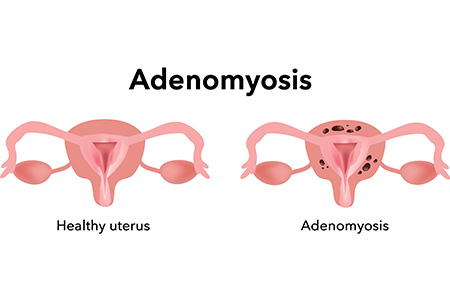Adenomyosis

Adenomyosis occurs when the cells that line the uterus (endometrial tissue) grow into the muscular wall of the uterus. As a result, the uterus becomes swollen and enlarged, typically causing painful, heavy periods.
Who gets adenomyosis?
Although you can experience adenomyosis at any time, you're most likely to develop it when you're in your 40s to mid-50s. This is typically when you're past childbearing, but may be still getting your period. There do not seem to be any risk factors or family history connections.
What causes adenomyosis?
The cause of adenomyosis is not fully understood. Some research suggests that damage to the inner wall of the uterus during pregnancy, labor, delivery or a surgical procedure may cause the condition.
What are the symptoms of adenomyosis?
Some women have no symptoms or are only mildly uncomfortable. However, more typically adenomyosis is characterized by:
- Heavy, painful or prolonged menstrual periods
- Bloating
- Low back pain
- Pelvic pain
- Frequent urination
- Painful intercourse
Since your uterus is enlarged, you may feel pelvic heaviness or tenderness.
How is adenomyosis diagnosed?
If you're experiencing symptoms, your gynecologist may identify adenomyosis during a pelvic exam. You may also have a vaginal ultrasound to confirm or diagnose this condition. Because the symptoms are similar to those experienced with fibroids, it's important to accurately diagnose adenomyosis so you receive the appropriate treatment.
How is adenomyosis treated?
If you aren't experiencing symptoms, or if your symptoms are mild, you may choose to have no treatment.
If you're experiencing symptoms, your gynecologist may prescribe birth control pills or a progesterone-only intrauterine device (IUD).
Your gynecologist may also suggest a hysterectomy to remove your uterus. Typically your ovaries would not need to be removed so you'd maintain hormonal function.